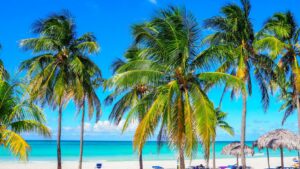Deciding on the best time to travel to Cuba is key to experiencing the island at its finest. With its vibrant culture, stunning beaches, and rich history, Cuba offers a unique adventure for every traveler. However, the timing of your visit can dramatically impact your experience, from the weather you’ll enjoy to the events you can attend.
Best Time To Travel To Cuba
Dry Season vs. Wet Season
 Selecting the best time to travel to Cuba significantly depends on understanding the island’s two main seasons: the dry season and the wet season. The dry season, running from November to April, offers travelers the most favorable weather conditions. During these months, visitors can enjoy clear skies, lower humidity, and moderate temperatures averaging around 26°C (79°F), making it the ideal period for exploring outdoor attractions, lounging on the beaches, and participating in cultural events. Additionally, this peak travel season coincides with several festive celebrations, providing a deeper insight into Cuba’s rich cultural heritage.
Selecting the best time to travel to Cuba significantly depends on understanding the island’s two main seasons: the dry season and the wet season. The dry season, running from November to April, offers travelers the most favorable weather conditions. During these months, visitors can enjoy clear skies, lower humidity, and moderate temperatures averaging around 26°C (79°F), making it the ideal period for exploring outdoor attractions, lounging on the beaches, and participating in cultural events. Additionally, this peak travel season coincides with several festive celebrations, providing a deeper insight into Cuba’s rich cultural heritage.
Conversely, the wet season spans from May to October, characterized by higher temperatures, increased humidity, and frequent rainfall. Though this time may deter some travelers, it presents unique advantages, such as fewer tourists and lower accommodation prices. Mornings often start sunny, with rain typically occurring in the afternoons, so planning activities for the earlier part of the day can maximize one’s trip during these months. This period is also suitable for visiting lush landscapes and natural attractions, as the rain brings vibrant life to Cuba’s flora and fauna.
Regional Climate Variations
When planning a trip to Cuba, it’s crucial to consider regional climate variations across the island. While the general climate is tropical, certain areas experience distinct weather patterns that can influence the best time to visit. For example, the eastern regions, including Santiago de Cuba and Guantanamo, tend to be warmer throughout the year, with higher humidity levels during the wet season, making the cooler months from November to April more comfortable for travel.
Peak Season in Cuba
Peak season in Cuba, characterized by cooler temperatures and minimal rainfall, spans from November to April. During these months, travelers experience optimum conditions for exploring the island’s rich cultural heritage, vibrant festivals, and stunning beaches. Choosing the best time to travel to Cuba involves considering the influx of tourists this season brings, as it coincides with the island’s dry season. Popular spots like Havana, Varadero, and Trinidad become bustling hubs of activity, offering an energetic atmosphere but also requiring advanced booking for accommodations and events. This period provides the perfect backdrop for outdoor adventures, city tours, and beach relaxation under the Caribbean sun, making it a favored time for visitors seeking the quintessential Cuban experience.
Off-Peak Travel Benefits
 Traveling to Cuba outside the peak season, especially during the months of May to October, offers notable advantages for visitors. It’s a period marked by fewer tourists, providing a more authentic experience of the island’s rich culture and stunning natural landscapes. Reduced visitor numbers mean easier access to popular tourist attractions without the crowds, allowing for more personal and immersive encounters.
Traveling to Cuba outside the peak season, especially during the months of May to October, offers notable advantages for visitors. It’s a period marked by fewer tourists, providing a more authentic experience of the island’s rich culture and stunning natural landscapes. Reduced visitor numbers mean easier access to popular tourist attractions without the crowds, allowing for more personal and immersive encounters.
Cost benefits significantly stand out during the off-peak season. Travelers can find better deals on accommodations, flights, and local services. Hotels and private rentals tend to lower their prices to attract visitors in these quieter months, making it an ideal time for budget-conscious travelers to explore Cuba.
Weather Patterns and Their Impact on Activities
Cuba’s weather patterns play a crucial role in determining the best time to travel to the island. Dry season, spanning from November to April, presents travelers with sunny days and low humidity, making it the ideal period for outdoor activities and exploring Cuba’s rich cultural heritage and pristine beaches. This season’s stable weather facilitates visits to historical sites in Havana, beach outings in Varadero, and hikes in the Viñales Valley, ensuring travelers can fully immerse themselves in the Cuban experience without the inconvenience of rain.
Conversely, the wet season, lasting from May to October, sees higher humidity and frequent rain showers, albeit usually short and intense, particularly in the afternoons.


